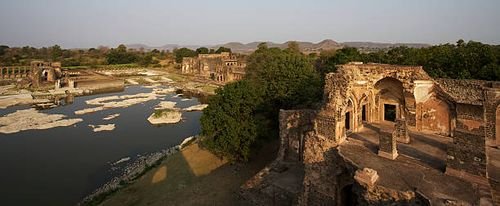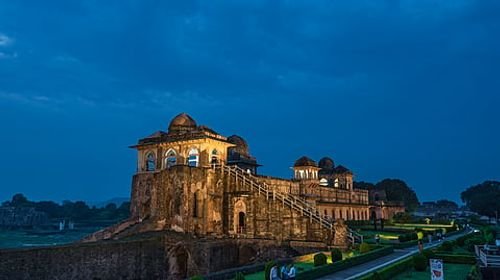Mandu, located in the Dhar district of Madhya Pradesh, is famous for its forts and palaces that echo tales of love, valor, and royal grandeur. Perched atop the Vindhya Range, Mandu sits at an elevation of about 633 meters, offering sweeping views of the Malwa plateau and the lush Narmada valley. Its charm lies in its stunning blend of history and nature, making it a year-round magnet for tourists.
Historical Significance
Mandu’s roots trace back to the sixth century, when it was an active trading center known as Mandapadurga. The Parmara dynasty fortified Mandu and shifted their capital here in the 10th and 11th centuries to ward off invasions, capitalizing on its strategic location. Mandu reached its zenith as the seat of the Malwa Sultanate under Afghan rulers, especially Hoshang Shah and later Baz Bahadur. Shadiabad, meaning “City of Joy,” was its Mughal name. The region came under Mughal influence and then Bahadur Shah of Gujarat in the 16th century, each leaving a mark on Mandu’s architecture and way of life.
Key Details:
Cultural Heritage
Mandu is not only an archaeological treasure but also a hub of living cultural traditions. Its streets resonate with Malwa’s folk music, ballads recounting the tragic romance of Baz Bahadur and Roopmati, and an annual Mandu Festival, which celebrates music, dance, poetry, and local cuisine. Adventure activities and water sports add modern flavor to its ancient setting, while Bhil tribal families now welcome visitors through homestays as part of rural tourism initiatives.
Top Tourist Attractions
Mandu’s allure is magnified by its unique and diverse architectural wonders.
- Jahaz Mahal (Ship Palace): Appears to float on water between two lakes, an Indo-Islamic masterpiece.
- Rani Roopmati Pavilion: A scenic lookout linked to the legendary queen, offering panoramic views of the Narmada valley.
- Baz Bahadur’s Palace: Reflects Mandu’s royal romance and Afghan heritage.
- Jami Masjid (Grand Mosque): Exemplifies Afghan architecture, famed for its marble work and colossal domes.
- Hindola Mahal (Swing Palace): Notable for its sloping walls and distinct design.
- Hoshang Shah’s Tomb: A precursor to the Taj Mahal, renowned for its exquisite marble work.
- Champa Baoli and Hammams: Ancient step-well and bathhouses exemplify it’s urban planning.
- Lohani Caves, Nilkanth Mahadev Temple, and several others complete the experience.

Location and Accessibility
Mandu lies about 95–97 km from Indore, making it a convenient getaway for both domestic and international tourists. The town’s coordinates are latitude 22.3601422 and longitude 75.3960536. It is well-connected by:
- Air: Nearest airport is Devi Ahilya Bai Holkar Airport, Indore (about 94–99 km).
- Rail: Nearest stations are Indore Junction (98 km) and Ratlam (124 km).
- Road: Well-connected via state highways; buses and taxis run from Indore, Bhopal (285 km), and nearby towns.
Major tourism websites offer detailed maps for first-timers and seasoned explorers alike.
Tourism Revenue and Visitor Statistics
Mandu is a prime revenue generator for Madhya Pradesh’s tourism sector. In 2025, the city received a ₹25 crore tourism facelift to upgrade facilities and support rural homestays. Visitor numbers have surged, with over 327,000 resident visits reported at Rani Roopmati Pavilion alone in 2024. Tourism not only boosts the local economy but also empowers Bhil tribal families and craftspeople through hospitality training and homestay opportunities.
Vibrant Local Culture
Mandu thrives as a cultural melting pot. Folk songs, local handicrafts, festivals, and cuisine add vivid colors to the already resplendent ruins. The Mandu Festival brings together artists from across India for music, dance, and adventure sports, reinforcing the town’s reputation as a center for experiential heritage tourism.
FAQs About Mandu
What is Mandu famous for?
It is renowned for its forts, palaces, Indo-Islamic architecture, and the romantic legend of Baz Bahadur and Rani Roopmati.
When is the best time to visit Mandu?
The ideal visiting period is from October to March, when the weather is pleasant and festivals bring extra vibrancy.
How to reach Mandu?
It is accessible via Indore’s airport and rail station, with regular buses and taxis, making it easy for travelers nationwide.
What are the top sites to see in Mandu?
Must-see attractions include Jahaz Mahal, Rani Roopmati Pavilion, Jami Masjid, Hoshang Shah’s Tomb, Baz Bahadur’s Palace, and Hindola Mahal.
How has tourism benefited Mandu?
Recent infrastructure upgrades worth ₹25 crore have improved tourist amenities, helped local families set up homestays, and boosted the economy.
Is Mandu suitable for family, solo, or adventure travel?
Yes. The cultural diversity, scenic views, historical intrigue, and adventure activities make it ideal for all traveler types.
Can I stay in Mandu?
Hotels, government rest houses, and rural homestays are now available, with Bhil tribal families offering authentic local hospitality and experiences.
Are guided tours available?
Yes. Multiple operators run guided tours focusing on history, architecture, and the local legend of Mandu’s romance.
Conclusion
Mandu, Madhya Pradesh, stands as a vivid chapter from India’s past, a fortress city with a soul, where architectural grandeur meets romantic legend and thriving local culture. Its visitor-friendly infrastructure, mapped routes, and unique stories make it a premier destination in central India. With the government’s commitment to sustainable tourism and local empowerment, it is poised to enchant visitors for generations.
